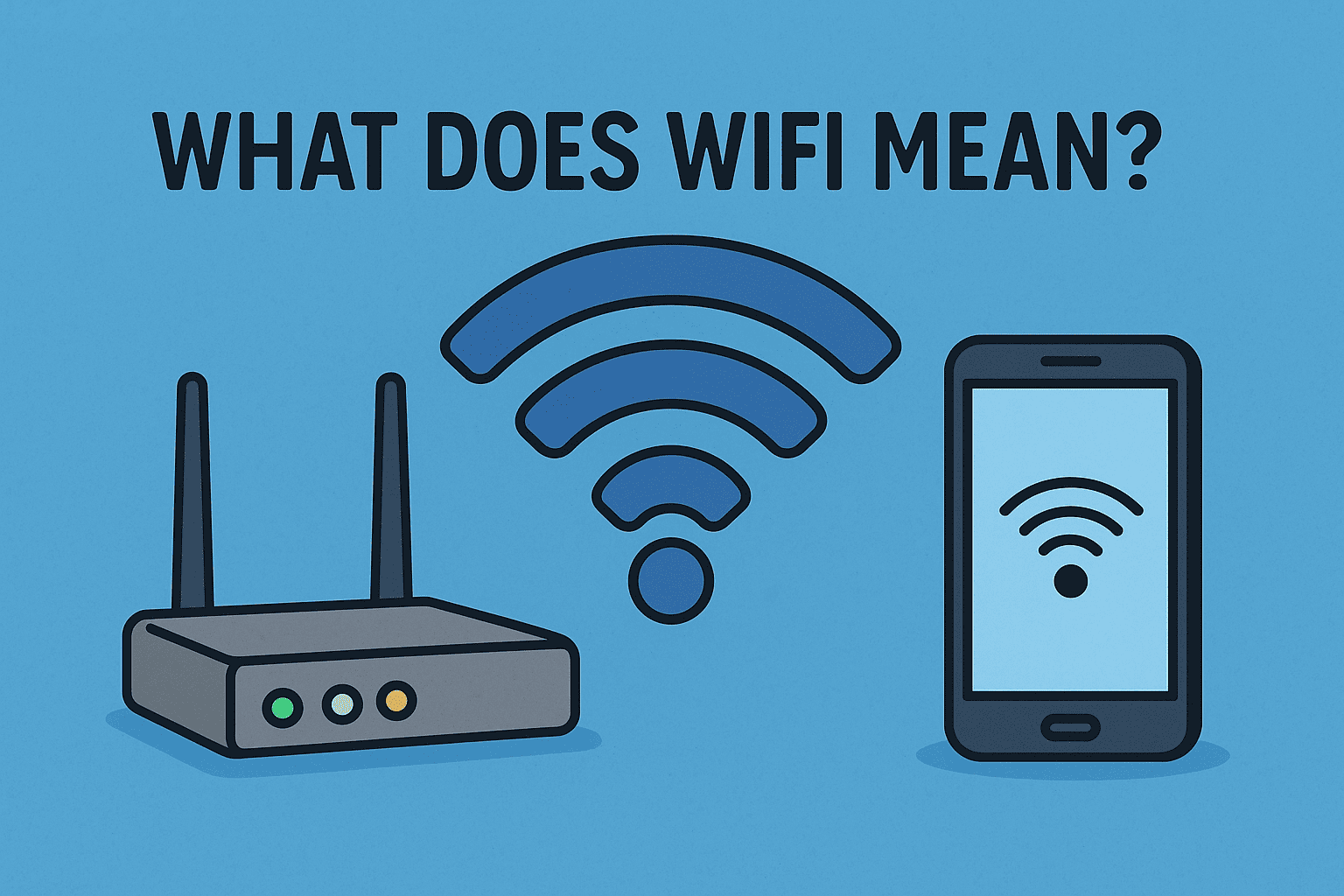Updated on September 23, 2025, by OpenEDR
Have you ever wondered, what does WiFi mean and how does it power the modern digital world? Today, WiFi is more than just an internet buzzword—it’s the foundation of connectivity for homes, businesses, and global communications. For IT managers, cybersecurity experts, and business leaders, understanding WiFi’s definition, security risks, and benefits is essential to keeping operations running smoothly.
This guide explores WiFi’s meaning, its history, how it works, and its role in cybersecurity, so you can make smarter decisions for your digital infrastructure.
What Does WiFi Mean?
WiFi stands for Wireless Fidelity, though the term is often used more as a marketing label than a strict acronym. In simple terms, WiFi refers to a set of wireless networking protocols based on IEEE 802.11 standards that allow devices like laptops, smartphones, and IoT systems to connect to the internet without physical cables.
Instead of relying on wired Ethernet, WiFi uses radio waves to transmit data between a router and connected devices, enabling fast, seamless communication.
A Brief History of WiFi
Understanding what WiFi means also requires looking at its origins:
1997 – The first version of IEEE 802.11 was introduced, offering speeds of 2 Mbps.
1999 – The Wi-Fi Alliance was formed to promote and standardize wireless technology.
2000s – WiFi became mainstream, replacing dial-up and wired LANs in homes and offices.
Today – WiFi 6 and WiFi 6E provide gigabit speeds and support for massive IoT ecosystems.
This evolution transformed WiFi from a niche technology into the backbone of global communication.
How WiFi Works
At its core, WiFi connects devices wirelessly to a router, which then links them to the internet. Here’s how the process works:
Router Sends Signals – The router broadcasts radio signals over 2.4 GHz or 5 GHz frequency bands.
Devices Connect – Smartphones, laptops, and IoT devices detect these signals and establish connections.
Data Transmission – Information is sent and received through encrypted radio signals.
Internet Access – The router connects to the modem, which communicates with your ISP.
This invisible flow of data is what keeps business operations, emails, and cloud apps running 24/7.
Why WiFi Matters for Businesses
For IT managers and CEOs, WiFi is more than convenience—it’s a strategic necessity. Here’s why:
Mobility – Employees can connect anywhere in the office.
Scalability – Businesses can easily add new devices without rewiring networks.
Cost Efficiency – Lower infrastructure costs compared to wired networks.
Remote Work Support – Enables secure VPN and cloud access.
Security Concerns with WiFi
While WiFi is powerful, it also poses cybersecurity risks if not properly managed.
Common Risks
Unauthorized Access – Hackers may exploit weak passwords.
Data Interception – Without encryption, data can be stolen in transit.
Rogue Hotspots – Attackers can trick users into connecting to fake networks.
IoT Vulnerabilities – Connected devices often have weaker security protections.
Best Practices for Secure WiFi
Always use WPA3 encryption instead of outdated WEP/WPA.
Change default router passwords immediately.
Enable firewalls and network segmentation.
Use VPNs for remote workers.
Regularly update router firmware.
WiFi Standards Explained
To fully answer what does WiFi mean, let’s break down the different standards:
WiFi 4 (802.11n) – Introduced MIMO technology, faster than previous versions.
WiFi 5 (802.11ac) – Higher speeds, better streaming, and lower latency.
WiFi 6/6E (802.11ax) – Supports multiple devices, IoT, and faster connections.
WiFi 7 (upcoming) – Promises even higher throughput and lower latency.
Each new version enhances speed, efficiency, and security.
WiFi and Cybersecurity
For businesses, WiFi must align with cybersecurity frameworks. Some strategies include:
Zero Trust Networking – Never trust, always verify.
Endpoint Security – Protect devices connecting to WiFi.
Threat Detection – Monitor WiFi traffic for unusual activity.
Managed Security Solutions – Partner with cybersecurity vendors like OpenEDR for continuous protection.
Future of WiFi Technology
WiFi is moving toward faster, smarter, and more secure systems:
WiFi 6E expands into the 6 GHz spectrum for higher performance.
AI-driven WiFi predicts and mitigates connectivity issues.
WiFi for IoT connects billions of devices securely.
Integration with 5G creates hybrid wireless ecosystems.
Businesses that invest in cutting-edge WiFi technology today will future-proof their operations.
FAQ: What Does WiFi Mean?
Q1. Is WiFi the same as the internet?
No. WiFi is the technology that connects devices to the internet, but the internet itself is the global network of connected servers and systems.
Q2. What does WiFi mean for security?
It means businesses must encrypt traffic, monitor devices, and prevent unauthorized access to avoid breaches.
Q3. Does WiFi stand for Wireless Fidelity?
Yes, though today it is commonly treated as a brand name rather than a literal acronym.
Q4. What is the difference between WiFi and mobile data?
WiFi uses local wireless routers, while mobile data connects through cellular networks like 4G/5G.
Q5. Can WiFi be hacked?
Yes, if networks are unsecured. That’s why WPA3 encryption, firewalls, and endpoint security are essential.
Conclusion
So, what does WiFi mean? It’s the invisible backbone of modern communication—allowing seamless wireless connectivity across homes, enterprises, and entire cities. But with its convenience comes risk. For businesses, securing WiFi means more than strong passwords—it requires robust cybersecurity strategies.
This is where OpenEDR excels. By combining endpoint protection, threat intelligence, and Zero Trust security, OpenEDR ensures that your WiFi network remains safe from hackers and cyber threats.
👉 Take control of your network security today. Register for Free and protect your business with OpenEDR’s enterprise-grade solutions.
